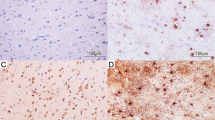Abstract
Delimitating the time of death becomes increasingly difficult and inaccurate, the further back it lays in time. To contribute to available techniques, pancreas and brain tissue from 500 corpses, whose time of death lay within 1 day and 23 days ±1 day, were immunohistochemically stained with anti-somatostatin and anti-glial fibrillary acidic protein (GFAP) antibodies. Somatostatin and GFAP are recognized as antigen by the employed antibodies. This does not occur when proteolytic processes after death disturb the tertiary structure, altering its antigen properties. In our cases, stainability of somatostatin in the pancreas was always given within 2 days after death. Hence, given a negative immunoreaction, death can be assumed to have occurred a minimum of 3 days before formaldehyde fixation, which stops the proteolysis. A negative immunoreaction occurred consistently after 11 days, indicating that if a positive reaction is obtained in a specimen, the death of the respective person must have occurred amaximum of 10 days before fixation. GFAP was always stainable in the frontal cortex within 3 days after death, which means that in the case of a negative immunoreaction, death can be assumed to have occurred a minimum of 4 days before fixation. A negative immunoreaction occurred consistently after 14 days, indicating that if a positive reaction is obtained in a specimen the death of the respective person must have occurred a maximum of 13 days before fixation. The presented methods provide further improvements of the possibilities of delimitating the time of death, whereby the combination of both methods allows a two-tailed delimitation.
Similar content being viewed by others
References
Henßge C. Die Präzision der Todeseinschätzung durch die mathematische Beschreibung der rektalen Leichenabkühlung. Z Rechtsmed 1979;83:49–67.
Henßge C. Temperatur-Todeszeit-Nomogramm für Bezugsstandarbedingungen der Leichenlagerung. Kriminalistik und forensische Wissensch 1982;46:109–115.
Rutty GN: The estimation of the time since death using temperatures recorded from the external auditory canal: Part I: Can a temperature be recorded and interpreted from this site. Forensic Sci Med Path 2005;1:41–52.
Rutty GN. The estimation of the time since death using temperatures recorded from the external auditory canal: Part II: Using single temperatures from this site to estimate the time since death with consideration of environmental or body “factors” that could affect the estimation. Forensic Sci Med Path 2005;1:113–124.
Klein A, Klein S. Die To deszeitbestimmung am menschlichen Auge. Diss Med (B), Med Akademie Dresden, 1978.
Dürwald W. Gerichtliche, Medizin. Barth, Leipzig, 1981.
Ith M, Bigler P, Scheurer E, et al: Observation and identification of metabolites emerging during postmortem decomposition of brain tissue by means of in situ 1H-magnetic resonance spectroscopy. Magn Reson Med 2002;48:915–920.
Ith M, Scheurer E, Kreis R, et al. 1H-MR-Spektroskopie in der forensischen Medizin I: Eine neue Methode zur Schätzung der postmortalen Liegezeit. V. 85, 80. Jahrestagung der Deutschen Gesellschaft für Rechtsmedizin Interlaken, Rechtsmed 2001;11:161.
Scheurer E, Ith M, Kreis R, et al. 1H-MR-Spektroskopie in der forensischen Medizin II: Eine Pilotstudie zur Todeszeitschätzung am Gehirn von Schafen und Menschen. V 86, 80. Jahrestagung der Deutschen Gesellschaft für Rechtsmedizin Interlaken, Rechtsmed 2001;11:162.
Scheurer E, Ith M, Kreis R, Bigler P, Boesch C, Dirnhofer R. 1H, Magnetresonanz Spektroskopie des Gehirns in situ zur Schätzung des postmortalen Intervalls. V 45, 81. Jahrestagung der Deutschen Gesellschaft für Rechtsmedizin Rostock-Warnemünde Rechtsmed 2002;12:267.
Wehner F, Schieffer M Chr, Wehner H-D, Subke J. Delimitation of the time of death by immunohistochemical insulin detection in pancreatic β-cells. Forensic Sci Int 1999;105:161–169.
Wehner F, Wehner H-D, Subke J. Delimitation of the time of death by immunohistochemical detection of glucagon in pancreatic β-cells. Forensic Sci Int 2002;124:192–199.
Wehner F, Wehner H-D, Schieffer M Chr, Subke J. Delimitation of the time of death by immunohistochemical detection of thyroglobulin. Forensic Sci Int 2000;110:199–206.
Wehner F, Wehner H-D, Subke J. Delimitation of the time of death by immunohistochemical detection of calcitonin. Forensic Sci Int 2001;122:89–94.
Namekawa M, Takiyama Y, Aoki Y, et al. Identification of GFAP gene mutation in hereditary adult-onset Alexander's disease. Ann Neurol 2002;52:779–785.
Jacque CM. The glial fibrillary acidic protein. Presse Med 1991;20:1384–1390.
Eng LF. Glial fibrillary acidic protein (GFAP): the major protein of glial intermediate filaments in different astrocytes. J Neuroimmunol 1985;8:203–214.
Wu VW, Schwartz JP. Cell culture models from reactive gliosis: new perspectives. J Neurosci Res 1998;51:675–681.
Pekny M. Astrocytic intermediate filaments: lessons from GFAP and vimentin knock-out mice. Prog Brain Res 2001;132:23–30.
Author information
Authors and Affiliations
Corresponding author
Rights and permissions
About this article
Cite this article
Wehner, F., Steinriede, A., Martin, D. et al. Two-tailed delimitation of the time of death by immunohistochemical detection of somatostatin and GFAP. Forens Sci Med Pathol 2, 241–247 (2006). https://doi.org/10.1385/FSMP:2:4:241
Accepted:
Issue Date:
DOI: https://doi.org/10.1385/FSMP:2:4:241




